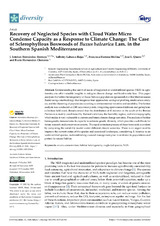Recovery of neglected species with cloud water micro condense capacity as a response to climate change: the case of Sclerophyllous Boxwoods of Buxus balearica Lam. in the Southern Spanish Mediterranean
Autor
Hernández Bermejo, Esteban
Labarca‑Rojas, Yalbeiry
Herrera-Molina, Francisca
Quero, José L.
Hernández Clemente, Rocío
Editor
MDPIFecha
2023Materia
Ex situ conservationHabitat heterogeneity
Neglected species
NUS
METS:
Mostrar el registro METSPREMIS:
Mostrar el registro PREMISMetadatos
Mostrar el registro completo del ítemResumen
Understanding the survival needs of neglected or underutilized species (NUS) in agroforestry can offer valuable insights to mitigate climate change and biodiversity loss. This paper analyses the habitat heterogeneity of Buxus balearica populations (palaeorelict of the Mediterranean Basin) using a methodology that integrates four approaches: ecological profiling, multivariate analysis, and the clustering of populations according to environmental variables and suitability. The habitat analysis was conducted on 240 occurrence points, integrating open-source databases and germplasm collection field work. Results reveal that the distribution of B. balearica in the south of the Iberian Peninsula is mainly conditioned by thermal variations, the humidity regime, and microtopography, which makes it very vulnerable to current and future climate change scenarios. The analysis of habitat heterogeneity demonstrates its capacity to estimate genetic diversity, which provides a solid basis for future research and conservation actions. The rapid extinction process of these boxwoods is evident by comparing the suitability model under different climate scenarios. There is an urgent need to improve the current status of the species and associated landscapes, considering B. balearica as an underutilized species, and establishing a sound management plan to reinforce its populations and protect its natural habitat.

